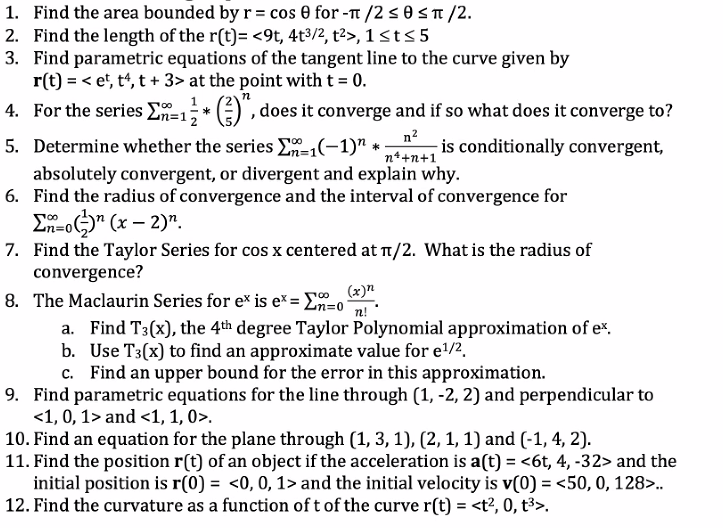Algebra & Trigonometry with Analytic Geometry
13th Edition
ISBN:9781133382119
Author:Swokowski
Publisher:Swokowski
Chapter11: Topics From Analytic Geometry
Section11.4: Plane Curves And Parametric Equations
Problem 34E
Related questions
Question
Need help with question 1, thank you.

Transcribed Image Text:1. Find the area bounded by r = cos 0 for -π/2 ≤0 ≤π/2.
2. Find the length of the r(t)= <9t, 4t³/2, t²>, 1 ≤ t ≤ 5
3. Find parametric equations of the tangent line to the curve given by
r(t) =< et, t4,t + 3> at the point with t = 0.
*
()", does it converge and if so what does it converge to?
n²
5. Determine whether the series E-1(−1)" * - is conditionally convergent,
n*+n+1
absolutely convergent, or divergent and explain why.
6. Find the radius of convergence and the interval of convergence for
Σn-on (x-2).
4. For the series Σn=
n=1;
7. Find the Taylor Series for cos x centered at π/2. What is the radius of
convergence?
(x)n
n!
100
8. The Maclaurin Series for ex is ex = Σn=0
a. Find T3(x), the 4th degree Taylor Polynomial approximation of ex.
b. Use T3(x) to find an approximate value for e¹/².
c. Find an upper bound for the error in this approximation.
9. Find parametric equations for the line through (1, -2, 2) and perpendicular to
<1, 0, 1> and <1, 1, 0>.
10. Find an equation for the plane through (1, 3, 1), (2, 1, 1) and (-1, 4, 2).
11. Find the position r(t) of an object if the acceleration is a(t) = <6t, 4, -32> and the
initial position is r(0) = <0, 0, 1> and the initial velocity is v(0) = <50, 0, 128>..
12. Find the curvature as a function of t of the curve r(t) = <t², 0, t³>.
Expert Solution
This question has been solved!
Explore an expertly crafted, step-by-step solution for a thorough understanding of key concepts.
Step by step
Solved in 2 steps

Recommended textbooks for you

Algebra & Trigonometry with Analytic Geometry
Algebra
ISBN:
9781133382119
Author:
Swokowski
Publisher:
Cengage

Algebra & Trigonometry with Analytic Geometry
Algebra
ISBN:
9781133382119
Author:
Swokowski
Publisher:
Cengage